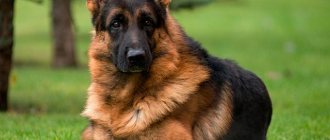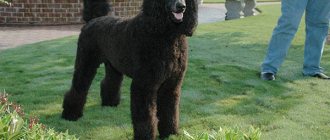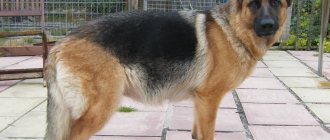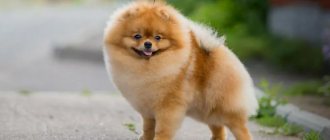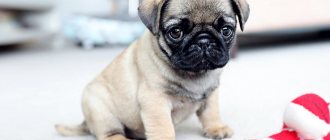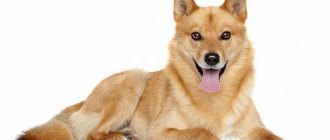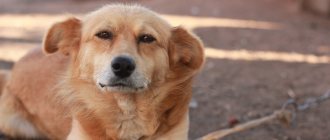Owners of modern German Shepherds are united in the largest cynological organization of one breed (WUSV), which is part of the Fédération Cynologique Internationale (FCI).
“The German Shepherd is, first and foremost, a working dog!” — considered the creator of the breed, von Stefanitz. This motto is still relevant today. The modern German Shepherd is a strong and resilient animal due to the harmonious combination of height, weight and shape. She is the personification of nobility, devotion, and good management. And these are mandatory properties for a working and protective dog.
Life expectancy for boys and girls
The life expectancy of female and male German Shepherds is almost the same . Their minimum lifespan is 5-7 years.
But usually “Germans” live about 10-14 years. Of course, there are also long-livers, but such cases are quite rare. Their life lasts 15-17 years.
Males live 1.5-2 years less than females.
Expert opinion
Kozhevin Semyon Kirillovich
Expert dog handler.
“Most of the dogs of this breed live about 12 years. Long-livers are very rare, and these are those dogs that in their youth led a fairly active lifestyle and were on a strict diet. These are representatives of the exhibition line. If your dog has lived with you for less than 10 years, then this is a signal that something in its maintenance was wrong. Because the German Shepherd has a genetically determined life expectancy of at least 12 years.”
Depending on the type
Life expectancy does not depend on the type of German Shepherd - it directly depends on care.
But many years of experience have proven that dogs with rare coat colors have the greatest endurance, and therefore greater longevity.
Dogs with a color that disqualifies the standard, on the contrary, have lower vitality rates in old age. This occurs due to a mutation at the gene level, because their colors are not typical for a German shepherd.
Breed Features
Historians testify that skeletons of dogs similar to a German shepherd were found during excavations dating back to the 4th century BC in the lands of modern Europe. Since ancient times, people have been attracted to the Shepherd by its impressive size and intelligence. The shepherds had no other communication except with the dog, which not only fulfilled its official duties, but was a faithful companion to its owner.
The breed attracted particular attention in the 18th century, when two types of German shepherds began to develop in parallel. One of them was a Thuringian semi-long-haired, gray herding dog, the second was a Württemberg with long hair of red or black color.
The Germans were different in character and temperament. Over time, they decided to combine them into one breed, preserving the best qualities of each. The result of the joint efforts of the breeders was presented at the Hanover Dog Show in 1882.
The breed attracted the attention of the public and won the sympathy of the audience. Already in 1891, the first society of lovers of this breed appeared. And although the organization existed for a short time, it nevertheless managed to register the breed standard. 1899 was marked by the creation of the Union of German Dog Owners. In 1868, on its basis, an international class association was created, which included 82 countries.
The breed attracted attention again in 1925 at one of the international exhibitions. Then there was the Great Patriotic War, which claimed the lives of millions of people, and many breeds of dogs also suffered. It was possible to resume breeding of the German Shepherd thanks to several surviving representatives of the breed.
The first is German. Shepherd Greif
How many live on the street and at home?
German Shepherds that live outdoors have a longer lifespan than those that live indoors.
This is due to the characteristics of the breed itself. Germans need physical activity, in which it is difficult and impossible to limit them, as well as mental activity, which manifests itself in training.
If you take away these aspects of your dog's life, it will have a negative impact on their physical and mental functioning.
The dog may become aggressive, its muscles will begin to weaken, and it will no longer be able not only to stand up for itself, but also to protect its owner.
If a German Shepherd is constantly kept in an enclosure on the street, this will lead to the same consequences.
Many dog breeds, on the contrary, feel more comfortable indoors, but the German Shepherd is not one of them. It is better and healthier for her to be outside - she is not afraid of rain and cold because of her dense undercoat and good coat.
Therefore, we can say with confidence that dogs living in the courtyard of a private house live much longer than those who have to huddle in an apartment.
But this does not mean at all that a German Shepherd cannot live indoors . Just provide her with the right amount of physical and mental stress.
General worker Labrador
www.boston.com
The most popular breed in the world is extremely friendly and can never harm a person, which means it is not suitable for guarding or patrolling. But the Labrador is an excellent rescuer, capable of detecting and pulling a person out from under the ruins.
These dogs confirmed their excellent working qualities during the Vietnam War. In addition, Labradors are often used in hospitals for therapy.
Age compared to human years
| Person's age | German Shepherd age | Compliance factor |
| 14 months | 2 months | 7.0 |
| 5 years | 6 months | 10.0 |
| 9 years | 8 months | 12,5 |
| 14 years | 12 months | 14.0 |
| 20 years | 18 months | 13,3 |
| 24 years | 2 years | 12.0 |
| 30 years | 3 years | 10.0 |
| 36 years | 4 years | 9.0 |
| 40 years | 5 years | 8.0 |
| 42 years | 6 years | 7.0 |
| 49 years old | 7 years | 7 |
| 56 years old | 8 years | 7 |
| 63 years old | 9 years | 7 |
| 65 years old | 10 years | 6,5 |
| 71 years old | 11 years | 6,5 |
| 75 years old | 12 years | 6,2 |
| 80 years old | 13 years | 6,3 |
| 84 years old | 14 years | 6,2 |
| 87 years old | 15 years | 5,8 |
| 89 years old | 16 years | 5,6 |
How to determine age?
You can most accurately determine the age of a German Shepherd by its appearance:
- If the puppy has already opened his eyes and is running around with all his might, it means he is already a month old;
- A compact and plump puppy, exploring the territory and weighing at least 10 kg, is most likely two months old;
- When a German Shepherd's ears begin to stand up, and the tail and limbs become disproportionately large, it means that she is already 3 months old;
- If you notice that the puppy has begun to shed, he is already 4 months old;
- The ears become fully erect and the set of teeth changes when the puppies reach 6 months. He is already becoming more and more like an adult dog.
- The dog is actively growing up to 10 months. At 10 months she already has the appearance of an adult dog;
- At 13 months, the dog’s coat completes its transformation and acquires a rich and final color;
- When a dog completely loses its childlike features, this is clearly visible on its face, which means its age has reached 2 years. She becomes more severe in appearance;
- Over time, the structure of the coat begins to change - this indicates the aging of the shepherd;
- When you notice that the fur has become more faded, gray hair has appeared on the muzzle, and the pet’s eyes have dimmed, it means that he has entered the period of old age.
Once you have figured out the appearance, back up your observations with knowledge about the behavior of German Shepherds.
The peak of a pet's activity occurs from birth to 4 years . Then the dog begins to get tired of its usual physical activity, and it has to be reduced.
When the dog does the exercises completely lazily, it means that old age and peace have set in. Now you just need to warm up with the shepherd, but not overload it.
It is necessary to distribute mental and physical stress based on the age of the dog.
Distinctive features
Recessive genes and a rich breed line divide the breed into subspecies:
- West German (main species);
- East German (larger and more powerful than the main type);
- Eastern European (bred by Soviet cynologists);
- Belarusian or black (bred in Belarus);
- Long-haired;
- Dwarf.
International cynological organizations recognize only the West German dog. Other subspecies have either partial recognition or only amateur clubs.
The West German German Shepherd is considered the standard and most correct. She is quite large ( 55-65 cm at the withers) and heavy ( 22-40 kg ). Initially, dogs were divided into large and small, but over time they were all reduced to one standard. The dog has a stretched format. The bones and muscle structure are strong and well built. The standard was last revised in 1996.
- The head is harmonious, wedge-shaped, moderately wide, moderately rounded. Proportional to the body. The cranial bones are visible, a groove is visible. Stop is expressed.
- The muzzle is equal in length to the skull. Tapers towards the nose. The bridge of the nose is straight. The lips are dense and thin. The jaw is strong and not wide. Scissor bite (the upper teeth completely overlap the upper teeth).
- The nose is large and black.
- The eyes are small, almond-shaped, slightly slanted, and set wide apart. The color of the iris is dark.
- The ears are medium-sized, stand on cartilage, parallel to each other and perpendicular to the head. Tapered and rounded at the ends. When running they can fold back.
- The body is strong and massive. The topline is curved and smooth. The back is inclined, smoothly transitions into a long sloping croup. The chest is well let down and the ribs are rounded. The neck is of medium length, moderately inclined (about 45° to the horizontal), wide, without dewlap.
- The tail is of medium length (reaches the hock joint), lowered in a calm state, rises slightly above the horizon line in an active state, but does not bend, surrounded by elongated hair.
- The limbs are straight, parallel, strong, muscular. The movements are sweeping, similar to the gait of a trot.
- The coat is thick, smooth, hard, and of medium length. Elongations and feathering on the neck, tail, and back of the thigh. Dense fluffy undercoat.
- Colors: pure black, black and tan, black with yellow or red spots.
Main causes of premature death
The causes of premature death can be congenital defects, but also acquired diseases.
Congenital diseases:
- Cryptorchidism and disorder of sexual dimorphism;
- Incorrect body proportions and height;
- Irregular tail shape (docked, carried over the back or ring-shaped);
- Incorrect muzzle shape (too short/long or blunt);
- Droopy or soft ears, malocclusion;
- Coat problems;
- Weak pigmentation and blue eyes;
- Excessive excitability, cowardice or lethargy.
But there are also acquired health problems caused by improper care:
- Insufficient amount of physical and intellectual activity;
- Improper maintenance (the dog is constantly in a cramped room - an apartment or an enclosure);
- Incorrect selection of food or diet in which the dog does not receive enough vitamins;
- The dog was not allowed to recover from the birth and was bred again;
- Dangerous work with risk to life;
- Physical activity when the dog has not yet recovered from any wounds or injuries.
Mating
Mating of pets can be either breeding or regular. It all depends on the pedigree of the dogs. Of course, if a bitch or a dog has any status and the necessary documents, then the mating must take place officially. To do this, the owners of the bitch need to obtain a special certificate from the kennel and find a suitable male. The mating date is agreed upon in advance.
- Until the female reaches 20-25 months , she cannot be bred.
- The first heat can occur at 8-10 months , but during this period the girl is still too weak to bear and give birth to healthy offspring.
- Usually the bitch is untied on the 13-15th day of the third heat, when the discharge becomes light and bloody, and the loop swells.
These dogs need a lot of space. The girl is brought to the territory of the male dog. You can walk the animals together to introduce them. If the male was able to mount, you need to help both pets start the process correctly. To do this, the female is held by the head and under the belly, and the male is directed into the noose. The act together with the castle lasts 15-20 minutes . Mating is repeated after 2 days .
How to extend the life of a pet
In order for your animal to please you for many years, you need to provide it with proper care and attention.
Provide your German Shepherd with plenty of activity - they need long walks, games, exercise, swimming . The better the physical shape of the animal, the longer it will be healthy and active.
Nutrition also plays an important role.
It should be useful and balanced. It is also necessary to focus on the age of the pet when creating a menu.
IMPORTANT!
A German Shepherd's diet must include a lot of meat, as well as vegetables and cottage cheese.
It is important to prevent your dog from overeating, because every 2 extra kg will shorten the dog’s life by a month..
Monitor your pet's health. The German Shepherd has an excellent body, hardy and strong, but if you do not monitor the dog’s condition, you can also shorten its life by several years.
Features of walking a shepherd dog
The physical activity of an adult animal is covered by daily long, at least half an hour, walks 2 times a day. These walks are enough to cope with natural needs. Puppies and young shepherd dogs require walks 4-5 times a day.
Attention! Walking should be done before feeding.
It is better to walk in places specially designated for this purpose. In public places, the pet must be muzzled and on a short leash.
Proper nutrition
Experienced breeders and owners of German Shepherds understand that creating the right menu for a German Shepherd is difficult at first. Then there are no problems with this.
Basic principles of diet for dogs:
- Proteins – up to 70%. This is meat without bones and fat, offal, cottage cheese, milk and eggs;
- Carbohydrates – up to 40%. They should be slow - porridge, as well as vegetables, fruits with fast carbohydrates, and fiber;
- Fats – from 20% to 40%. They must be of plant and animal origin.
Despite the fact that proteins are very useful for shepherds, you cannot focus only on proteins . The dog needs to get all its vitamins.
You need to choose food that is suitable for a dog at its age.
For example, for a puppy, the fat content of food is reduced so as not to cause obesity, but for an adult dog, on the contrary, the amount of protein is increased.
Quality maintenance and care
Life expectancy largely depends on external factors, not only on congenital ones. To keep your pet healthy for many years, you need to monitor its health, provide proper and healthy nutrition, exercise, but that’s not all.
The place where the German Shepherd is located must be clean and tidy, be it an enclosure or a bed in an apartment . The dog should never eat stale or spoiled food, and the water in the bowl should be changed every two days.
You will also need to take care of your pet's coat and appearance. He needs to be combed, bathed, his fur and nails trimmed, and his ears cleaned. If necessary, wipe your eyes and nose.
Despite the fact that the “Germans” have excellent health and can live on the street, you should not leave them if the temperature drops much below zero.
This is especially true for puppies, nursing mothers and older dogs. They may not tolerate such conditions and simply die.
The German Shepherd needs communication with its owner and other dogs.
This will help her socialization and relieve loneliness and various mental disorders.
Caring for an older dog
- For an older dog, you need to create a separate diet. Since they absorb proteins worse than young ones, but they need it, the quality of this element needs to be changed. Also, older dogs need to eat as little phosphorus as possible - it can lead to kidney failure.
- It is necessary to reduce the amount of physical activity, because the dog will no longer be able to maintain the activity that he had without problems. His health now deserves more attention than usual. Many owners attribute all the dog’s behavior to old age, not realizing that the dog could be seriously ill with something.
- You need to take your dog to the vet twice a year. This will help you notice any deviations from the norm in the “German” state.
- Your dog still needs to be vaccinated. Her health is now more vulnerable, so she cannot refuse vaccinations.
- You need to brush your dog’s teeth yourself and regularly using a special toothpaste. Animals usually like its taste, so they quickly get used to this procedure.
- Brush your pet regularly and bathe it often. During these processes, inspect for tumors or wounds. The mucous membranes should be pink, just like those of a healthy dog.
- Do not change the dog’s normal rhythm of life. He should be in a loving family, as before, eat regular food. If you get a new dog, give your old one as much time and attention as you give her.
